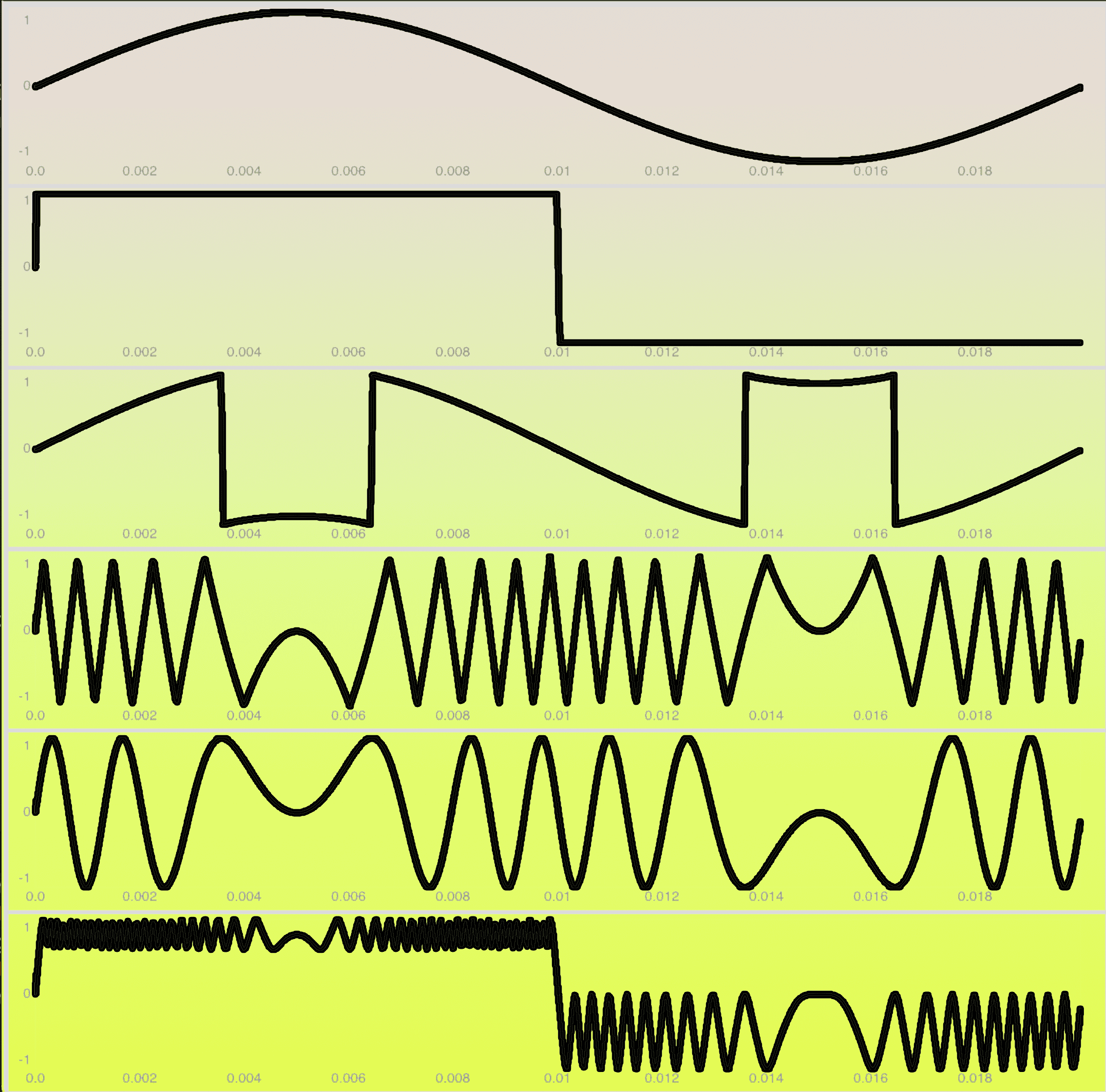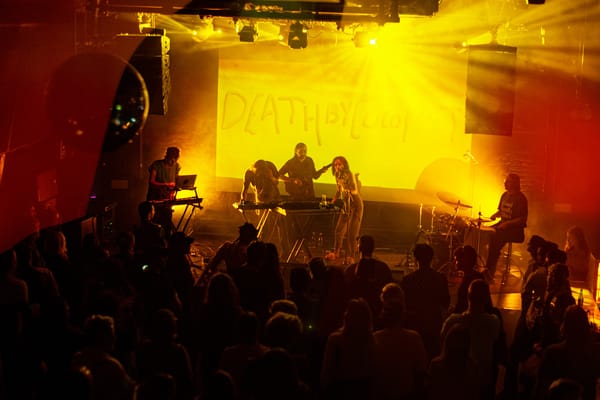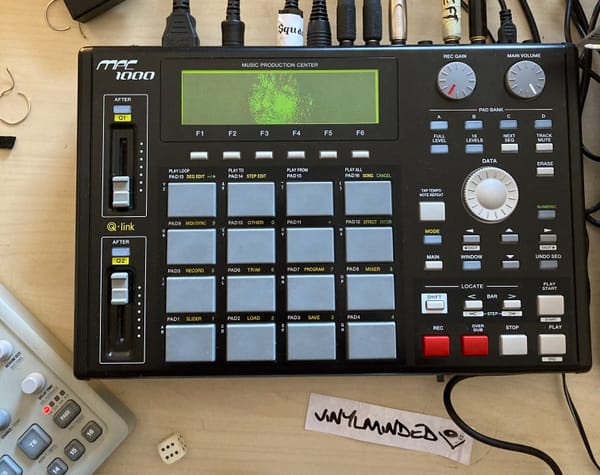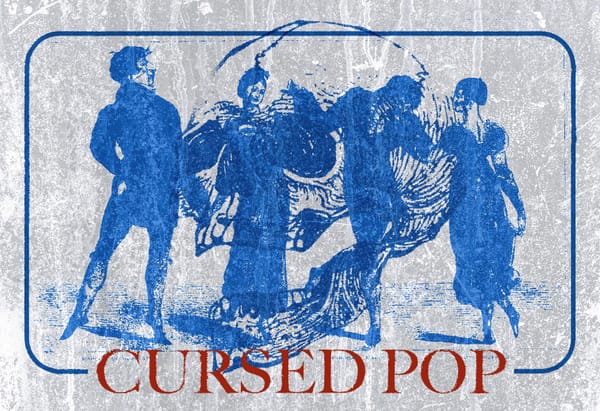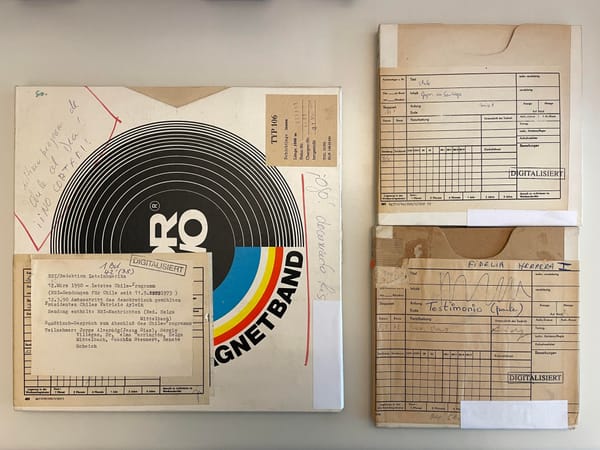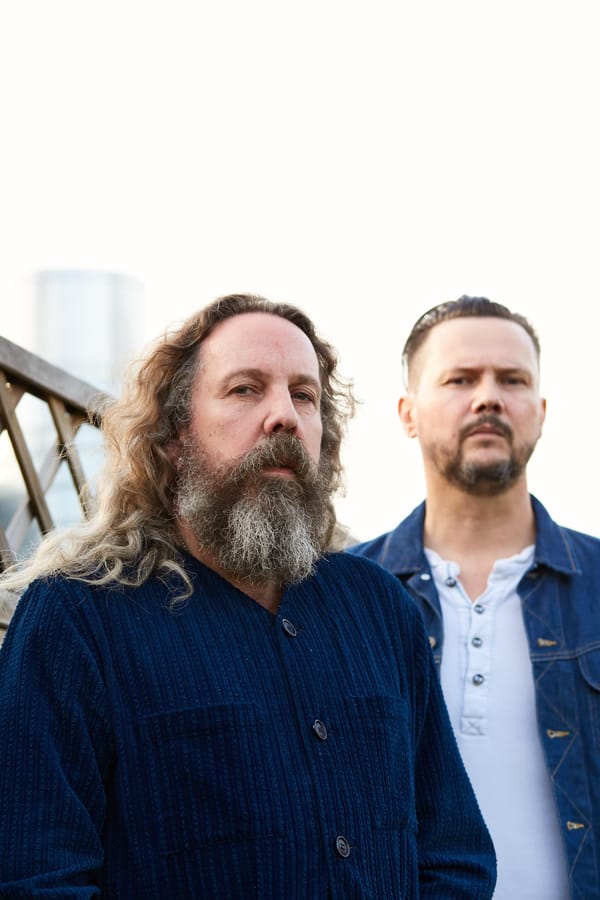Register for free to receive our newsletter, and upgrade if you want to support our work.
In noise music, extreme volume is an effective means of involving listeners with their entire bodies. Pedro A. Ramírez examines how musicians use volume artistically and what role the sound carrier plays in this process. Ramírez uses personal experiences, interviews and theoretical approaches.
I decided to write about this topic as I picked up a CD copy of Morton Feldman’s composition for Bunita Marcus. In its back cover I read in a thin roman font: “The volume of For Bunita Marcus is extremely low, for realistic listening turn the volume-knob down.”
I found the gesture very atypical, out of the normal, as I’ve always encountered the extreme opposite of this suggestion in almost every punk, noise or experimental record I’ve come across with. The records suggested something along the lines of PLAY LOUD or AS LOUD AS POSSIBLE. Since they almost never provide a specific sound pressure value i.e 120db or any other technical reference point, it exposes how the intention is rather to push the listener a little bit further than he’d normally would be used to, suggesting that the context of the listening experience is that of intensity, of energetic sonic matter.
Although I deeply enjoy the virtues of silence and contemplation, the following words are skewed towards the loudness, being the side of the extremes I have spent my time reflecting on the most, both in theory and in practice, as a former guitar player in hardcore punk bands and as a sound artist working with electronic sounds.
BYPASSING THE MIND – TUNING THE BODY
Whenever the topic of loud electronic music is concerned, the name of Zbiegniew Karkowski usually comes to the table. Throughout the years he won a big reputation on playing stupidly loud concerts of electronic sound, destroying speaker cones and emptying concert halls of afraid listeners. He found himself in the special tangent point between contemporary composition and industrial music.
There’s an interview of him on Vimeo from around the late 1980’s in which the interviewer, Malga Kubiak, poses the questions: “Why does Zbiegniew Karkowski play so loud? Why is his music so aggressive?” He dodges the question by replying how his creative intentions come from a different place: From love rather than destruction. Karkowski defines music as flows of energy that he then uses as tools for “bypassing the defense mechanisms” the audience builds. He is interested in intensity as a way to skip the expectations and prejudices preventing them from really experiencing the sound matter. He proceeds to explain that his music is not made to address the brain, but a phenomenon that is targeted to the body. “People experiencing it should feel like they are in a vacuum, completely there. They cannot even hear their own thoughts. Nothing there of their preconceptions and expectations. It’s just the primal feeling. Being there.”
The volume structures the listening space and engages bodily hearing. This ranges from the extremes of the annulment of space via sonic density to the creation of new aural spaces from a combination of existing sounds. The volume collapses back into the music as more detailed information or meaning is lost due to high levels.
Excerpt from Noise/Music by Paul Hegarty
BORDERLINE AESTHETICS
I’ve been trying to find what happens when the sound is played loud? Noise as volume → folding as an ever reproduction of harmonics – beyond the threshold.
To shatter the hearing into thousands of pieces. Going hard, pushing beyond.
Going hard in volume leads to auditory distortion: the folding of sound waves bouncing and multiplying ad infinitum. What Jimi Hendrix and others found so pleasing driving their guitar amplifiers so hard was harmonic distortions that would result in the curvatures being compressed against their limits. The sharpening of their edges, the multiplicity.
In my personal research exploring sound design in digital and analog synthesizers, I’ve become obsessed with techniques to achieve colors, meaning different timbral variations, by the usage of waveform distortion. One of the most basic forms is called clipping and occurs when an amplifier is overdriven and attempts to deliver an output voltage or current beyond its maximum capability. The sound waves are then “cut” resulting in a hard-edged wave, resembling a squared-shape wave. Sonically this produces a lot of harmonics, making the sound brighter, harsher to the ears. Also, because of the presence of these new frequencies, it would appear to sound louder when mixed with other sources.
Similarly to this clipping there are other techniques, such as wave folders, in which the sound waves are “folded” in a user defined threshold. This border becomes a sort of edge, a “frontier” in which waves would bounce back and forth in an ever-going ricocheting of vibrations that would translate as harmonics in the auditory.
At the end sound could be described as wiggly air, vibrations. Loudness as maximum intensity displays yet another material possibility of the sound. Pumping your chest, shaking your skull. It takes the breath out of you as you experience the pressure in your throat.
As Marie Thompson describes in her book Beyond Unwanted Sound, noise and loudness are very much closely related, partly because every sound amplified beyond healthy limits becomes unbearable, unintelligible and formless. This cascading excess of saturation distorts the listeners perception, it triggers the survival instincts, posits the musical experience into one of danger, alertness.
When sound is loud, we can feel it, it pushes us. When talking about tools for using distortion in a creative way, I’ve been very fascinated about the selection of words used in the presets of different plugins working with distortion and saturation. Rust, Velcro tape, asphalt, sandpaper, rubber hammer, chipped glass, frost, blizzard, crispy.
What you hear is revealed as electrically driven movements of air; sound is materialized, and becomes other to the expressing body. Music is now evidently a prosthetic, mediated through machinery and this shakes the belief in the centeredness intention and authenticity of musical creation.
Paul Hegarty, Electric on Noise/Music
BREAKING THE CEILING
Although we could say we’re currently living in the post-loudness war era, since Spotify and other streaming services have started to reduce the volume and keep the levels under healthy measures, I’ve been on the quest of the opposite: to revisit the harsh noise music cannon in search for something that could be named as “the loudest record ever”. As obvious as it is, the infamous album Pulse Demon by Merzbow needs to be mentioned simply because of how many times it has been used as an example of a creative use of digital mastering in the CD production. It is said that the mastering engineers pumped extra numbers into its loudness, causing the CD players to sound uncommonly loud. Merzbow wanted to reach the new extra headroom that the CD format could give him.
Another recollection of similar experiences of imprinted loudness on physical formats can be found in records by the Japanese Free Jazz guitarist Masayuki Takayanagi. Based on an interview with Jim o’Rourke for the podcast NOISEXTRA, he describes how “the grooves were cut so deep that you could hear the record without any amplification, straight into the air”. His recording Mass Projection, alongside Kaoru Abe, is definitely a “certified hood classic” of mine.
Something I find interesting is how different devices or processes fold the signal in particular and singular ways. It’s impossible to separate the sound of American Harsh Noise from the compression and distinct sound of cassette tape saturation. Probably the trademark distorted sound of the band Les Rallizes Dénudés came more from bootleg recordings of their live shows than by their own intention. I like to think about those overdrives as the color of the edges, the borderlines of the playback mediums.
Loudness has always been this quality of Rock Music that has kept me around the style, even though I stray far from pretty much every subgenre by now. Loudness or the impression of it is something that still informs my practice as a sound artist. This sort of characteristic, idiom is something that the British-Austrian musician and label owner Peter Rehberg would constantly mention in interviews when referring to his appeal for Merzbow or his appraise for Kevin Drumm. In an article about his label Editions Mego in 2003, Rehberg explained how Drumm’s album Sheer Hellish Miasma was sort of a commission for him to explore his interest with extreme forms of Metal Music. SHM is abrasive, abstract, and angry. An exploded version of the rustiest bits of the shittiest Norwegian Black Metal distortion pedal sound recorded straight to tape – a turning point for the musician who was previously known for his guitar preparations in the electroacoustic improvisation circles of Chicago in the late nineties.
After Erstwhile announced the second version of SHM, I became obsessed with the record again, this time reading on forums about other possible candidates that would be on par with it in terms of loudness, such as Carlos Giffoni’s Arrogance and Gallon Gravy by Pain Jerk. As I listened to digital copies of them on iTunes, I was quite disappointed because they didn’t seem inherently any louder. Of course, I was only listening to mp3 versions of them, but I found out by checking the Spectral Analyser in Adobe Audition that iTunes automatically normalizes the sound to retain dynamic consistency between different songs, tuning them down for an equalized intensity hearing experience.
HAPTICS OF SOFT ~ QUIET
I enjoy thinking about the idea of phase transitions such as when ice turns into water and water into steam. It happens as well when pulses turn into tones, and is something that the philosopher and composer Haela Ravenna Hunt-Hendrix uses to describe her system of composition. One particularly beautiful example is when she describes how extreme Metal, in its quest for reaching the highest points of “heaviness”, crosses some threshold and turns into ambient. When the blast beats go so fast, and the tremolo guitars blend altogether, they create this bed of sound, this continuity that resembles string orchestras and beds of white noise. Although a similar phenomenon would occur in Harsh Noise with the HNW (Harsh Noise Wall) sub-genre (a style of noise music composition that attempts to take variation, dynamics and consequently dramaturgy out, allowing the direct sonic experience of texture and energy over extended periods of time), I’m more interested in the shift from loudness into the quiet and the sparse, as it happened in experimental music scene in the late 1990’s and early 2000’s in Japan with Onkyô, a style of electroacoustic improvisation focusing on minimalism and exploration of textural details of acoustic and electronic sound.
Novak, Hegarty and others have written about it, framing Onkyô as this moment when the experimental music scene started using space and quietude as a creative tool. Novak expands saying that this dim and delicate sound-world would originate in the specific venue where the concerts happened, an art space called Off Site.
Some musicians claimed that Onkyô’s performance aesthetics sprung from Off Site’s physical limitations. The space was so small and close to other houses as to require quiet performances, since neighbors would complain if sound leaked through the thin wooden walls. The quietness of the space became a hallmark of Onkyô’s performative silence, as well as the special kind of listening associated with the genre, as audiences came to Off Site prepared to listen with deep concentration.
Excerpt from Playing Off Site by David Novak
What intrigues me the most about the Onkyô project is that it still holds the radical and aggressive features of the japanese noise but this time replacing loudness and the endless multiplication of harmonics into using the extreme opposites: High pitched sine waves and the usage of gaps, digital silence, between sonic events.
I’ll never forget the sensation when working at an office doing computer work while listening to the recording of Un Peu du Neige Salie by Bernhard Günter, a computer music piece that shares Feldman’s aesthetics of duration and soft dynamics. At the time my job consisted of lots of manual work, a highly monotonous activity. I was thrilled when I realized I had been enjoying pretty much “nothing”, as the recording had stopped a long time ago. It felt in a way as the ultimate ambient musical experience.
Hearing Roxanne Metáyer live in Kunst-Station Sankt Peter Church earlier this year threw me into a state of complete awe. That was something I have almost never experienced as the threshold between acoustic and electronic blended so tastefully between the natural reverb of the church. The level was so soft and the trails of the echoes were so blurry that even the click of my phone home button felt like an intruder in the space. Her selection of tools was greater than her last performance in Cologne last year, but this time every instrument felt chosen carefully based on its acoustic properties to be diffused in the space. The wood of the violin, the delicate harmonics of little bells and chimes. I know it’s unhealthy to compare yourself with other artists, but I had to question myself about my own usage of dynamics. Would loudness ever be able to reach an ecstatic moment such as the phase transition between the acoustic/electric in a highly reverberant space?

Pedro Ramírez photographed by Ezequiel Angeloni
Featured image: Pedro A. Ramírez
This article is brought to you by noies.nrw as part of the EM GUIDE project – an initiative dedicated to empowering independent music magazines and strengthen the underground music scene in Europe. Read more about the project at emgui.de.
Funded by the European Union. Views and opinions expressed are however those of the author(s) only and do not necessarily reflect those of the European Union or the European Education and Culture Executive Agency (EACEA). Neither the European Union nor EACEA can be held responsible for them.


